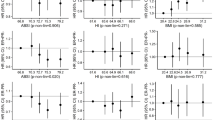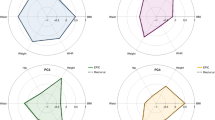Abstract
Purpose
A body shape index (ABSI) has been proposed as a possible improvement over waist circumference (WC) as a marker of abdominal adiposity because it removes the correlation of WC with body mass index (BMI) and with height. We assessed the association of ABSI with four obesity-related cancers compared to that of other anthropometric measures of adiposity.
Methods
We used data from the Women’s Health Initiative, a large cohort of postmenopausal women, recruited between 1993 and 1998 and followed until September 2013, to assess the associations of ABSI and other anthropometric measures with risk of cancers of the breast, endometrium, colorectum, and kidney. The four comparison anthropometric measures were BMI, WC, waist circumference-to-height ratio (WHtR), and waist-hip ratio (WHR). Over a median of 12.7 years of follow-up, among 143,901 women, we identified 7,039 invasive breast cancers, 1,157 endometrial cancers, 1,908 colorectal cancers, and 376 kidney cancers. We used Cox proportional hazards models to estimate the association of quintiles of the five measures with risk of the four cancers.
Results
Unlike the other anthropometric indices, ABSI was not associated with increased risk of breast or endometrial cancer. BMI and WC were comparable as predictors of breast and endometrial cancer, and these associations were unchanged after mutual adjustment. For colorectal and kidney cancers, ABSI was a significant predictor comparable to BMI; however, WC showed the strongest association with colorectal cancer, and WC, WHtR, and WHR all showed stronger associations with kidney cancer.
Conclusion
In contrast to other anthropometric measures, ABSI showed no association with risk of breast or endometrial cancer and was more weakly associated with risk of colorectal and kidney cancers compared to more established measures of central adiposity.
Similar content being viewed by others
Change history
27 July 2017
An erratum to this article has been published.
References
World Cancer Research Fund (2007) Food, nutrition, physical activity, and the prevention of cancer: a global perspective, 2nd edn. American Institute for Cancer Research, Washington, DC
Renehan AG, Tyson M, Egger M, Heller RF, Zwahlen M (2008) Body-mass index and incidence of cancer: a systematic review and meta-analysis of prospective observational studies. Lancet 371:569–578. doi:10.1016/S0140-6736(08)60269-X
Prentice AM, Jebb SA (2001) Beyond body mass index. Obes Rev 2(3):141–147
Janssen I, Katzmarzyk PT, Ross R (2005) Body mass index is inversely related to mortality in older people after adjustment for waist circumference. J Am Geriatr Soc 53:2112–2118
Pischon T, Boeing H, Hoffmann K, Bergmann M, Schulze MB, Overvad K et al (2008) General and abdominal adiposity and risk of death in Europe. N Engl J Med 359:2105–2120
Kuk JL, Ardern CI (2009) Influence of age on the association between various measures of obesity and all-cause mortality. J Am Geriatr Soc 57:2077–2084
Petursson H, Sigurdsson JA, Bengtsson C, Nilsen TI, Getz L (2011) Body configuration as a predictor of mortality: comparison of five anthropometric measures in a 12 year follow-up of the Norwegian HUNT 2 study. PLoS ONE 6:e26621
Folsom AR, Kaye SA, Prineas RJ, Potter JD, Gapstur SM, Wallace RB (1990) Increased incidence of carcinoma of the breast associated with abdominal adiposity in postmenopausal women. Am J Epidemiol 131:794–803
Huang Z, Willett WC, Colditz GA, Hunter DJ, Manson JE, Rosner B, Speizer FE, Hankinson SE (1999) Waist circumference, waist:hip ratio and risk of breast cancer in the Nurses’ Health Study. Am J Epidemiol 150:1316–1324
Kaaks R, van Noord PA, Den Tonkelaar I, Peeters PH, Riboli E, Grobbee DE (1998) Breast cancer incidence in relation to height, weight and body-fat distribution in the Dutch “DOM” cohort. Int J Cancer 76:647–651
Canchola AJ, Chang ET, Bernstein L, Largent JA, Reynolds P, Deapen D, Ursin G, Horn-Ross PL (2010) Body size and the risk of endometrial cancer by hormone therapy use in postmenopausal women in the California Teachers Study cohort. Cancer Causes Control 21:1407–1416
Kabat GC, Heo M, Wactawski-Wende J, Messina C, Thomson CA, Wassertheil-Smoller S, Rohan TE (2013) Body fat and risk of colorectal cancer among postmenopausal women. Cancer Causes Control 24:1197–1205
Bosy-Westphal A, Geisler C, Onur S, Korth O, Selberg O, Schrezenmeir J, Müller MJ (2006) Value of body fat mass in the assessment of metabolic risk factors. Int J Obes 30:475–483
Ashwell M, Gunn P, Gibson S (2012) Waist-to-height ratio is a better screening tool than waist circumference and BMI for adult cardiometabolic risk factors: systematic review and meta-analysis. Obes Rev 13:275–286
Gunter MJ, Hoover DR, Yu H, Wassertheil-Smoller S, Rohan TE, Manson JE, Li J, Ho GY, Xue X, Anderson GL, Kaplan RC, Harris TG, Howard BV, Wylie-Rosett J, Burk RD, Strickler HD (2009) Insulin, insulin-like growth factor-1, and risk of breast cancer in postmenopausal women. J Natl Cancer Inst 101(1):48–60. doi:10.1093/jnci/djn415
Kabat GC, Kim M, Caan BJ, Chlebowski RT, Gunter MJ, Ho GY, Rodriguez BL, Shikany JM, Strickler HD, Vitolins MZ, Rohan TE (2009) Repeated measures of serum glucose and insulin in relation to postmenopausal breast cancer. Int J Cancer 125(11):2704–2710. doi:10.1002/ijc.24609
Kabat GC, Kim MY, Strickler HD, Shikany JM, Lane D, Luo J, Ning Y, Gunter MJ, Rohan TE (2012) A longitudinal study of serum insulin and glucose levels in relation to colorectal cancer risk among postmenopausal women. Br J Cancer 106:227–232
Krakauer NY, Krakauer JC (2012) A new body shape index predicts mortality hazard independently of body mass index. PLoS ONE 7:e39504
WHO (2011) Waist circumference and waist-hip ratio: report of a WHO expert consultation, Geneva, 8–11 December 2008. Technical report, World Health Organization
Krakauer NY, Krakauer JC (2014) Dynamic association of mortality hazard with body shape. PLoS ONE 9:e88793
Friedenreich CM (2001) Review of anthropometric factors and breast cancer risk. Eur J Cancer Prev 10:15–32
Lahmann PH, Hoffmann K, Allen N, van Gils CH, Khaw KT, Tehard B et al (2004) Body size and breast cancer risk: findings from the European Prospective Investigation into Cancer and Nutrition (EPIC). Int J Cancer 111:762–771
Gaudet MM, Carter BD, Patel AV, Teras LR, Jacobs EJ, Gapstur SM (2014) Waist circumference, body mass index, and postmenopausal breast cancer incidence in the Cancer Prevention Study-II Nutrition Cohort. Cancer Causes Control 25:737–745
Huang Z, Hankinson SE, Colditz GA, Stampfer MJ, Hunter DJ, Manson JE, Hennekens CH, Rosner B, Speizer FE, Willett WC (1997) Dual effects of weight and weight gain on breast cancer risk. JAMA 278:1407–1411
Friedenreich C, Cust A, Lahmann PH, Steindorf K, Boutron-Ruault MC, Clavel-Chapelon F et al (2007) Anthropometric factors and risk of endometrial cancer: the European prospective investigation into cancer and nutrition. Cancer Causes Control 18:399–413
Hoffmeister M, Raum E, Winter J, Chang-Claude J, Brenner H (2007) Hormone replacement therapy, body mass, and the risk of colorectal cancer among postmenopausal women from Germany. Br J Cancer 97:1486–1492
Pischon T, Lahmann PH, Boeing H, Tjønneland A, Halkjaer J, Overvad K et al (2006) Body size and risk of renal cell carcinoma in the European Prospective Investigation into Cancer and Nutrition. Int J Cancer 118:728–738
Prineas RJ, Folsom AR, Zhang ZM, Sellers TA, Potter J (1997) Nutrition and other risk factors for renal cell carcinoma in postmenopausal women. Epidemiology 8:31–36
Nicodemus KK, Sweeney C, Folsom AR (2004) Evaluation of dietary, medical and lifestyle risk factors for incident kidney cancer in postmenopausal women. Int J Cancer 108:115–121
Seidel JC, Pérusse L, Després JP, Bouchard C (2001) Waist and hip circumferences have independent and opposite effects on cardiovascular disease risk factors: the Quebec Family Study. Am J Clin Nutr 74:315–321
The Women’s Health Initiative Study Group (1998) Design of the Women’s Health Initiative clinical trial and observationa study. Control Clin Trials 19:61–109
Langer RD, White E, Lewis CE, Kotchen JM, Hendrix SL, Trevisan M (2003) The Women’s Health Initiative Observational Study: baseline characteristics of participants and reliability of baseline measures. Ann Epidemiol 13:S107–S121
McTiernan A, Kooperberg C, White E, Wilcox S, Coates R, Adams-Campbell LL, Woods N, Ockene J, Women’s Health Initiative Cohort Study (2003) Recreational physical activity and the risk of breast cancer in postmenopausal women: the Women’s Health Initiative Cohort Study. JAMA 290:1331–1336
Curb JD, McTiernan A, Heckbert SR, Kooperberg C, Stanford J, Nevitt M, Johnson KC, Proulx-Burns L, Pastore L, Criqui M, Daugherty S, WHI Morbidity and Mortality Committee (2003) Outcomes ascertainment and adjudication methods in the Women’s Health Initiative. Ann Epidemiol 13(9 Suppl):S122–S128
Willett WC, Stampfer MJ (1986) Total energy intake: implications for epidemiologic analyses. Am J Epidemiol 124:17–27
Maruthur NM, Bolen S, Brancati FL, Clark JM (2009) Obesity and mammography: a systematic review and meta-analysis. J Gen Intern Med 24:665–677
Chlebowski RT, Hendrix SL, Langer RD, Stefanick ML, Gass M, Lane D, Rodabough RJ, Gilligan MA, Cyr MG, Thomson CA, Khandekar J, Petrovitch H, McTiernan A, WHI Investigators (2003) Influence of estrogen plus progestin on breast cancer and mammography in healthy postmenopausal women: the Women’s Health Initiative randomized trial. JAMA 289:3243–3253
Acknowledgments
This paper was supported through institutional funds from the Albert Einstein College of Medicine.
Conflict of interest
None of the authors has a conflict of interest.
Author information
Authors and Affiliations
Corresponding author
Additional information
An erratum to this article is available at https://doi.org/10.1007/s10552-017-0931-x.
Appendix: Short list of WHI investigators
Appendix: Short list of WHI investigators
Program Office: (National Heart, Lung, and Blood Institute, Bethesda, Maryland) Jacques Rossouw, Shari Ludlam, Dale Burwen, Joan McGowan, Leslie Ford, and Nancy Geller
Clinical Coordinating Center: Clinical Coordinating Center: (Fred Hutchinson Cancer Research Center, Seattle, WA) Garnet Anderson, Ross Prentice, Andrea LaCroix, and Charles Kooperberg
Investigators and Academic Centers: (Brigham and Women’s Hospital, Harvard Medical School, Boston, MA) JoAnn E. Manson; (MedStar Health Research Institute/Howard University, Washington, DC) Barbara V. Howard; (Stanford Prevention Research Center, Stanford, CA) Marcia L. Stefanick; (The Ohio State University, Columbus, OH) Rebecca Jackson; (University of Arizona, Tucson/Phoenix, AZ) Cynthia A. Thomson; (University at Buffalo, Buffalo, NY) Jean Wactawski-Wende; (University of Florida, Gainesville/Jacksonville, FL) Marian Limacher; (University of Iowa, Iowa City/Davenport, IA) Robert Wallace; (University of Pittsburgh, Pittsburgh, PA) Lewis Kuller; (Wake Forest University School of Medicine, Winston-Salem, NC) Sally Shumaker
Women’s Health Initiative Memory Study: (Wake Forest University School of Medicine, Winston-Salem, NC) Sally Shumaker
For a list of all the investigators who have contributed to WHI science, please visit: https://cleo.whi.org/researchers/SitePages/Write%20a%20Paper.aspx
Rights and permissions
About this article
Cite this article
Kabat, G.C., Xue, X., Kamensky, V. et al. Risk of breast, endometrial, colorectal, and renal cancers in postmenopausal women in association with a body shape index and other anthropometric measures. Cancer Causes Control 26, 219–229 (2015). https://doi.org/10.1007/s10552-014-0501-4
Received:
Accepted:
Published:
Issue Date:
DOI: https://doi.org/10.1007/s10552-014-0501-4




